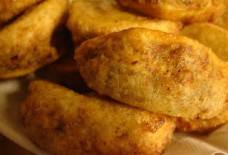Young writers explore common ground between Muslims and Latinos
Wearing a hot-pink hijab covering her head, Rida Hamida asked more than a dozen teenage Latino writers how Muslims and Muslim Americans like herself are portrayed in the media.
“Terrorists,” one in the group said.
Hamida then asked, “What does Donald Trump say about Latinos and Mexicans?”
“Criminals,” another young writer responded. “And rapists,” added a classmate.
But who are Latinos, really? Hamida asked. They responded: teachers, lawyers, public officials, activists, business owners, soldiers.
“I want you to then see the same for Muslims,” Hamida, 38, said. “So we are the doctors, lawyers, businessmen.”
The commonalities didn’t begin there, Hamida told the teenagers during the third event of her project Adventures of Al-Andalus, at Santa Ana College. From 711 to 1492, she told the group, Muslims occupied most of what are today Spain and Portugal, known then as Al-Andalus, and the two cultures formed one community.
During that period, the natives borrowed 4,000 words from the Arabic language, shared common spaces and married each other, which is why many Latino surnames end in “-ez,” said Hamida, who started the Al-Andalus project about six months ago.
In Orange County, Latinos making up the majority of Santa Ana’s population are neighbors to the Muslim Americans in Anaheim’s Little Arabia. The project is a grassroots movement to unite the two cultures by rewriting their identity and challenging stereotypes such as racial profiling.
“I’m used to getting some looks when I walk down the street,” said Benjamin Vazquez, a partner in the project and a Valley High School world history and ethnic studies teacher.
“He has big brown eyes, thick hair like Muslims do,” Hamida said. “When I walk down the street, with his beard, I get looks. People are scared! It’s real. It’s like, ‘Wow.’”
The teenagers laughed. All 17 were in the middle of a weeklong Barrios Writers program aimed at empowering youths through creative writing, college-level workshops and cultural arts.
They stayed engaged as they heard commonality after commonality — including that Muslims also fear deportation when their visas expire.
But perhaps food was the fastest way to their hearts and minds.
Hamida brought several platters full of Arabic food and pointed out the shared cuisine: garbanzo beans, cilantro, jalapeños, olives, rice, salsa, even flat, round bread.
The teenagers filled their plates with the familiar items and chicken and beef kebab, but few touched the hummus, so Hamida went around serving them some and explaining it was simply blended garbanzo beans.
“Just try it, man, it’s really good. It’s just like fried beans you would eat,” Valley High senior Christian Sida, 17, told Adrian Martinez, 14, who didn’t want hummus on his plate.
Martinez hesitated, but tried the spread with the meat.
“I don’t know, it just looks weird,” the Orange County School of the Arts ninth grader said. “But it was really good.”
With their stomachs full, the teenagers got to work on their assignment, writing poems on how their community has crossed borders, emulating the style of the late Palestinian poet Mahmound Darwish, whom they had studied earlier.
“I will do it all for mi familia, for mi gente para que vean que estamos presente,” said Godinez Fundamental High School senior Mario Reyna, 17, reading what he wrote. Translated to English, it means: “I will do it for my family, for my people so they can see we are present.”
Barrios Writers founder Sarah Rafael Garcia complimented Reyna’s poetry.
“It’s like Darwish’s poem — very soothing but still having some disappointment,” she said.
At the end of the session, some of the writers worked on the leftover food. Since there were no more plates, Century High School sophomore Patricia Morales, 15, loaded rice, chicken kebab, fattoush salad and salsa onto a khubz flatbread and rolled it into an “Arabic burrito” to go.
“It feels like home,” said her sister Diana Morales, 19, a UC Santa Cruz sophomore, following suit and taking a bite.
It’s probably not the last time the teenagers will interact with Hamida and other Muslim American activists and their culture.
Just as Hamida invited Garcia on a tasting tour of Little Arabia — the project’s second event — and Garcia in turn invited Hamida and Vazquez to talk to the class, Hamida plans to invite the Barrios Writers to a fourth event planned for the fall, a “get-out-the-vote against Donald Trump” activity.
“It’s to get the kids to vote as one bloc — Latinos and Muslims,” Hamida said, “Because the hate rhetoric is against both of us.”
Orange County has more than 62,000 Muslims who voted in 2012, said Hamida, who also works as a community liaison for U.S. Rep. Loretta Sanchez, D-Orange. Santa Ana, alone, has more than 253,000 Latinos, according to city statistics.
Reyna said he already knew Muslims are often falsely portrayed in the media, but said he didn’t know they have so much in common with Latinos.
“I think the fact that I didn’t know that before says a lot about how much we don’t know,” he said. “We’re oppressed in the same way and it’s what brings us closer as people.”


